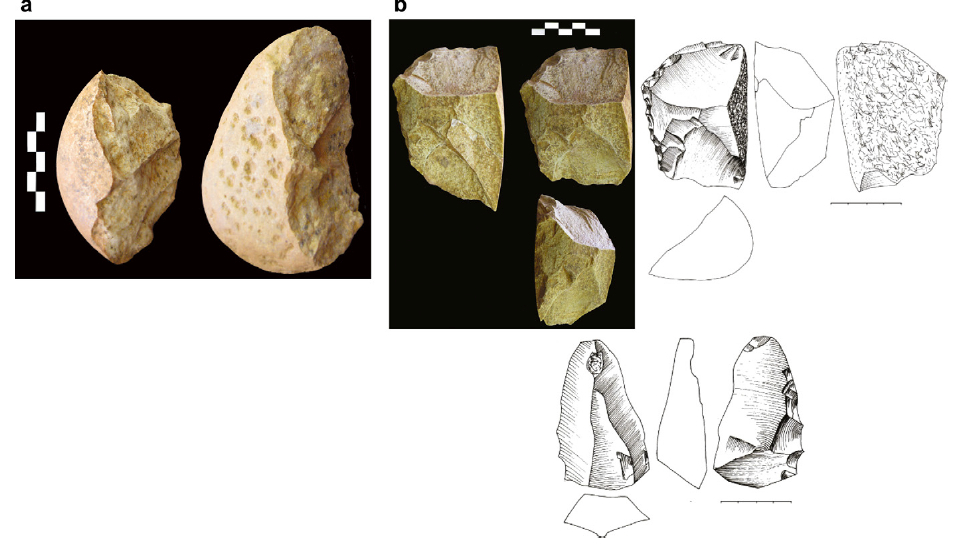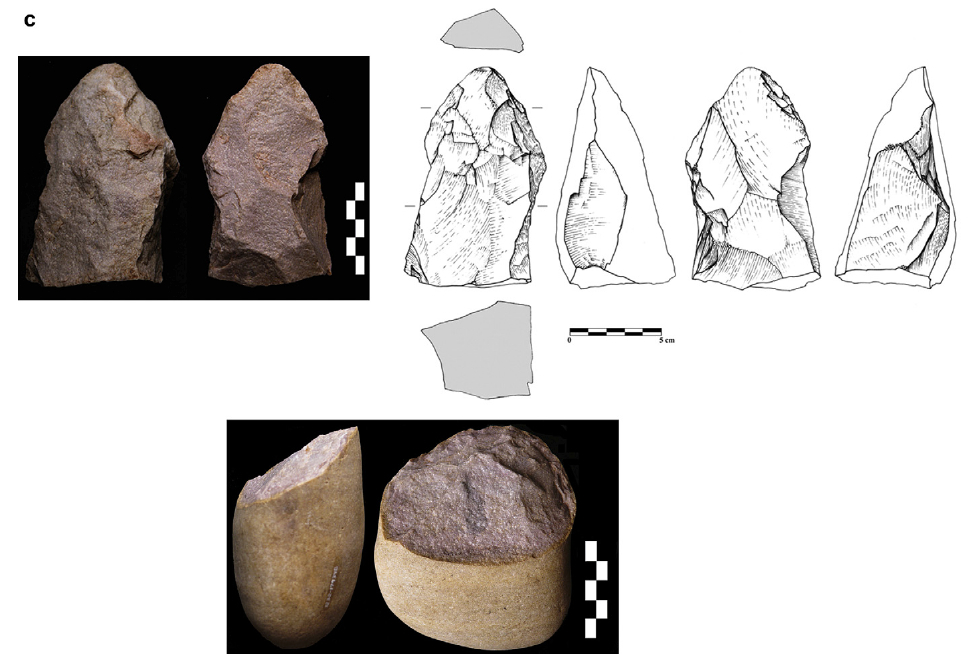The Toca da Tira Peia Site and the End of an Ice Age in American Archaeology
Journal of Archaeological Science 40 (2013), 2840-2847 http://dx.doi.org/10.1016/j.jas.2013.02.019
Human Occupation in South America by 20,000 BC: The Toca da Tira Peia Site, Piauí, Brazil
Christelle Lahaye, Marion Hernandez, Eric Boëda, Gisele D. Felice, Niède Guidon, Sirlei Hoeltz, Antoine Lourdeau, Marina Pagli, Anne-Marie Pessis, Michel Rasse, Sibeli Viana.
When and how did the first human beings settle in the American continent? Numerous data, from archaeological researches as well as from palaeogenetics, anthropological and environmental studies, have led to partially contradictory interpretations in recent years, often because of the lack of a reliable chronological framework. The present study contributes to the establishment of such a framework using luminescence techniques to date a Brazilian archaeological site, the Toca da Tira Peia. It constitutes an exemplary case study: all our observations and measurements tend to prove the good integrity of the site and the anthropological nature of the artifacts and we are confident in the accuracy of the luminescence dating results. All these points underline the importance of the Toca da Tira Peia. The results bring new pieces of evidence of a human presence in the north-east of Brazil as early as 20,000 BC. The Toca da Tira
Peia thus contributes to the rewriting of the history of the peopling of the American continent.
In 2010, Hamilton & Buchanan in the article “Archaeological Support for the Three-Stage Expansion of Modern Humans across Northeastern Eurasia and into the Americas” wrote
“the distribution of sites, and the boundaries…demonstrate that currently there is no archaeological evidence of human settlements to the east of the extreme western border of Beringia until well after the LGM, ~16k calBP… Assuming the initial expansion out of southern Siberia occurred ~45k calBP a pre-LGM colonization of the Americas would require a continuous expansion process with no pause along the western boundary of Beringia. The velocity of this expansion would have to be twice as fast as the empirical gradient shown in panel A and sites throughout Beringia would have to be at least twice as old as the current archaeological record indicates. A pre-LGM colonization would also require the extensive human occupation of Beringia during the extreme cold, hyper-arid conditions of much of MIS 2. Although there are only a handful of dated Upper Paleolithic sites throughout western and central Beringia, a pre-LGM colonization of the Americas would require a radical reformulation of the Eurasian Upper Paleolithic archaeological record as it currently stands.”
Lahaye et al. (2013) published a paper that does precisely that – it demands a radical reformulation not just of the Paleoindian archaeological record but of the Eurasian Upper Paleolithic archaeological record as well. The Toca da Tira Peia rockshelter in Brazil (originally discovered in 2008) has yielded 113 knapped artifacts from 4 perfectly preserved layers dated from 4,000 to 22,000 YBP by luminescence techniques. The anthropogenic origin of the lithic artifacts is beyond doubt (see Fig. 5 below), the dating method is top of the line and is widely used to date artifacts in the Old World, and the oldest dates are some 10,000 years older than Clovis.
Lahaye et al. (2013) map out the current distribution of confirmed and potential archaeological sites in South America (see below, Fig. 1 and 2). The usual thick curve starts thinning out at the Clovis threshold indicating that some fundamental demographic changes did occur in the New World at the end of the Ice Age and the frequency of sites correspondingly increased, but the pre-Clovis presence is undoubtedly there and it is deep.
It will take a while for archaeologists to circumscribe the emerging pre-Clovis lithic and cultural pattern in North and South America. It will take them even longer to trace it back to the Old World. Once they build another theory of the colonization of the Americas and spend a couple of decades mocking and suppressing all the attempts to find something even older in the New World, a new paradigm of human antiquity in the New World based on a set of even earlier sites will surely emerge.
Scientists should stop trying to offer answers to the ontological questions of whether humans were or weren’t in the New World on the basis of a fragmentary archaeological record, but instead embrace a thoroughly empirical stance of searching for older and older sites in the New World, while practicing good archaeology. Geneticists who use the archaeological record as a calibration scale for the molecular clock should be reminded that the former is a moving target. Hopefully the epistemological Ice Age in American archaeology is over and the Fiedels of the world are a thing of the past. (The tireless warrior against crackpottery, Stuart Fiedel, has turned into a crackpot himself when he suggested that the Toca da Tira Peia tools were made by capuchin monkeys.) The great antiquity of human presence in the Americas was correctly predicted by such non-antiquarian disciplines as synchronic linguistics (see Nichols, Johanna. “Linguistic Diversity and the First Settlement of the New World,” Language 66: 475-521) and kinship studies (Dziebel, German V. The Genius of Kinship. Youngstown: Cambria Press, 2007), which suggests that only a holistic, cross-disciplinary approach to human origins can result in accurate reconstructions of deep human history.





I have been reading up on these issues for the last two weeks, and I am absolutely bewildered by all the brandnew evidence, both hard and circumstancial. To sum up:
a) Siberian DNA has been sequenced clearly linking a Siberian group as ancestral to native Americans (some 17000 BC).
b) In spite of their reservations native Americans have also been sequenced.
c) An early native American child (some 13000 BC) has now turned up for sequencing, and has been estimated to have been part of a gene-pool ancestral to up to 80% of the modern native American (North and South!).
d) There are strong arguments in favour of a cultural (sic!) injection from Solutrea leading to Clovis-technology.
e) Solutrea ended about 17000; Clovis happened 13000-ish. Gap: 4000 years.
f) The Siberian group mentioned under a) had less than 4000 years to make it to various regions in the Americas.
g) They did so (if they did!) via either a land- or a sea-route. The former has been called into question, the latter is under scrutiny (costal route).
h) There is a very suggestive map on the modern distribution of Haplo-group X, massing up on either side of the North Atlantic. However, all that red colour was solid ice back then, and these ‘Haplos’ must have been on their way to the Americas in Siberia (consequence of a). A question might be how far this red smear would stretch westward on an imaginary map showing the same distribution for 17000 BC.
i) No Solutrean genetic material has been found anywhere in the Americas as far as we know. Obviously, because we have no idea what that DNA would look like!
j) Just who brought the technique to the Americas (if they did, but flintknappers say that it is likely) is very much in question. They must have been marine-adapted, as well as somewhat removed from the Solutreans proper, especially in time! But possibly in kinship as well …
k) The Altamira cave-paintings show a sort of curraghs (boats made of animal hides). And what seem to be sails! Hence a navigeable sea-route is not out of the question, whatever some geologists might say. Whether this was a one- or a two-way route is an important question. In other words, did it happen by accident or at will? Could they go and come back?
l) Remains of ancient Americans don’t look like native Americans, they look like Patrick Stewart. But their DNA tells a different story. Obviously the fenotype-genotype thing is difficult to wrap one’s mind around. If Kenniwick Man were sequenced – and I suspect this has been done on the quiet – his DNA might very well belong to the same group as the Montana child. One can only admire those chaps of the past who made sense of things without sequencing!
m) The controversy does not really concern the question ‘Who got there first?’. There had been people in South America for ages when these guys arrived, that is getting more obvious every year. The controversy is a racial issue, and as such an educational problem, to do with respect for people, academic discipline, also for ‘the truth’, that has peculiar shapeshifting qualities …
n) Furthermore it is also, or has long been, an academic snake-pit issue: ‘Who gets the funding?’ In this field there are prize-fighters that will stop at nothing. These seem to be all on the Beringian side …
What can one deduce from a) to n)?
1. Yes, ancient bones belong 99% to the forefathers, and can be claimed for decent and respectful reburial, even if they look like Patrick Stewart.
2. The Solutrean option is by no means buried! But they have little to no hard evidence to back it up. Too many of their perfectly plausible points simply cannot be proven either way.
3. Perhaps they have relied too heavily on pushing back the time-frame, thus discrediting the landroute.
4. The Solutrean side is 3 – 1 down in the second half: they have a lot of work to do, especially in Europe. At the moment it looks as if the Beringia side are winning hands down.
5. I am all for the Solutreans … Come on Solutrea!! Come on!! Get in there!! Do something about point i)!!
6. But there’s no way Beringia are ever going to finish first! They are not even in the highest group … It is all second division pathetic mayhem.
PS I think it’s not the Africans … I think it’s the Australians.
A lot of archaeologists are forgetting that there were multiple Ice Ages, at intervals of about 12000 years. Those glaciers moving south through Canada and into current U.S. were like bulldozers as far as what they would have done to hearth sites. That’s a very logical reason why we don’t find any hearth sites in Alaska or Canada or the U.S. much older than 12-13000 years. Previous sites were destroyed by succeeding glaciers. There are4 sites in South America, no glaciers during the Ice Ages, that radiocarbon dating has placed at over 30,000 years old. Current archaeologists are reluctant to recognize and accept those dates. Yet, they continue to find hearth sites in South America significantly older than Clovis sites. No acceptable explanation has been offered yet.